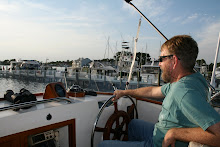 One trait that distinguishes folks who are REAL familiar with operating boats is that, when underway, they occasionally (but habitually) turn around and take a gander at where they've come from, whether it be day or night. There are a couple of reasons for doing this.
One trait that distinguishes folks who are REAL familiar with operating boats is that, when underway, they occasionally (but habitually) turn around and take a gander at where they've come from, whether it be day or night. There are a couple of reasons for doing this.First, lookin' backwards keeps you updated on traffic approaching from the stern--always a good idea. After all, how you deal with traffic from behind is quite likely going to affect how you deal with traffic coming from ahead. On the Betty Jane, for example, I glance aft every couple of minutes while toodling along. And I always shoot a glance over my shoulder before making a turn. Cutting some poor devil off with a boat can be just as dicey as cutting 'em off with a car!
Second, lookin' backwards helps you stay in whatever channel you happen to be passing through at the time. Currents and breezes often set or push vessels crosswise in channels. Under such circumstances, you may be happily aiming your bow for the appropriate spot between two upcoming channel markers but, without looking at the channel markers aft to gauge the effects of sideways set, you may also be skirting the channel's edge or even sliding subtly into dangerously shallow water. Don't take chances--glance over your shoulder and line up a previous marker (or markers) with an upcoming marker on the same side. Draw an imaginary line between the two by eye. Are you actually IN the channel? Just takes an instant or two.
And third, lookin' backwards is an easy way to check on the accuracy of your seemingly picture-perfect radar picture. Seafaring novices, I've noticed, tend to exaggerate their reliance on radar. While radar units are undeniably excellent (and exceptionally sensitive) these days, they are still subject to various forms of interference, some of it emanating from the very vessels they're installed on. It's not totally beyond the realm of possibility, even in these modern times, to see all-clear astern on your screen when there's actually a boat back there following close, even a large one, hidden amidst the clutter. Yikes! A fast over-the-shoulder glance lets you know for sure.






